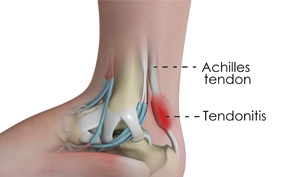Achilles Tendinitis

What is the Achilles Tendon?
The Achilles tendon is a group of tough fibrous tissue that connects the calf muscles to the heel bone. It functions to lift the heel while walking or running.
What is Achilles Tendinitis?
Achilles tendinitis refers to the inflammation of the Achilles tendon.
What are the Causes of Achilles Tendinitis?
Constant overuse or repetitive activities can cause Achilles tendinitis. These activities exert excessive stress on the tendon and lead to micro-tears.
Participating in sports and exercises can increase your risk of developing Achilles tendinitis. It is also commonly seen in people whose occupation puts lot of pressure on their feet and ankles. Simple movements like running, jumping, stretching and improper shoes can also result in the rupture of the tendon.
What are the Symptoms of Achilles Tendinitis?
The common symptoms related to Achilles tendinitis include:
- Swelling and bruising
- Mild or severe pain
- Stiffness
- Loss of strength
- Decreased movement of the ankle
- Muscle weakness or tenderness
- Difficulty in walking or standing
How is Achilles Tendinitis Diagnosed?
Diagnosis is based on the following:
- Medical history
- Physical examination of the foot and ankle to assess movements and condition of the tendon
- Radiological investigations such as foot or ankle X-rays or MRI scans
What are the Treatment Options for Achilles Tendinitis?
Treatment options depend on the duration and extent of injury to the tendon. Mild cases can be treated by the following approaches:
- Take adequate rest.
- Your doctor will prescribe medications to relieve pain and inflammation.
- Apply ice bags over a towel on the affected area for 15 to 20 minutes to reduce swelling and inflammation.
- Restrict activities that cause pain and stress for a short duration.
Your doctor will immobilize your foot with a cast, splint, brace, walking boot or other device, to prevent movement of your leg and assist in faster healing of the tendon.
Physical therapy modalities such as strengthening exercises, massage, ultrasound therapy, stretching and a walking rehab program are advised to improve range of motion.
Surgery is indicated only in severe cases and depends on the age and activity level of the individual, extent of damage to the tendon, and other factors.
Strictly follow the post-treatment instructions and wear appropriate shoes for the foot type and activity as recommended by your doctor to prevent the recurrence of the condition.
Related Topics
- Sprained Ankle
- Achilles Tendinitis
- Ankle Arthritis
- Ankle Instability
- Ankle Fractures
- Arthritis of the Ankle
- Achilles Tendon Problems
- Heel Pain
- Ankle Stress Fractures
- Corns
- Posterior Tibial Tendon Dysfunction
- Ankle Rheumatoid Arthritis
- Talus Fractures
- Vertical Talus
- Heel Spur
- Medial Gastrocnemius Strain




